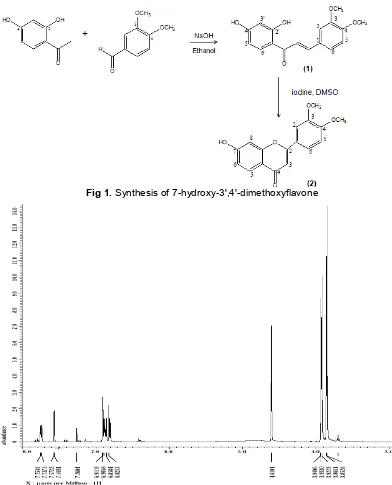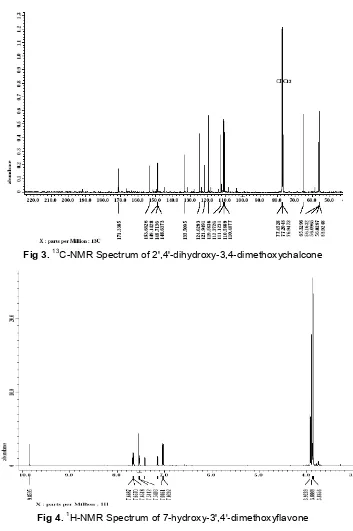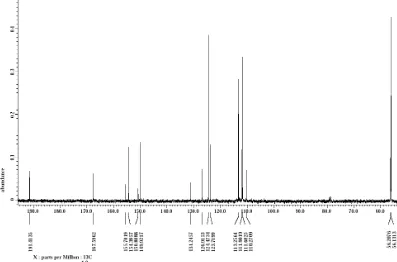SYNTHESIS, CHARACTERIZATION AND ANTIOXIDANT ACTIVITY OF
7-HYDROXY-3',4'-DIMETHOXYFLAVONE
Elfi Susanti VH
1,2,*, Sabirin Matsjeh
2, Tutik Dwi Wahyuningsih
2,
Mustofa
3, and Tri Redjeki
11
Department of Chemistry, PMIPA FKIP, Sebelas Maret University, Jl. Ir Sutami 36 A Surakarta Indonesia, 53126
2
Department of Chemistry, Faculty of Mathematics and Natural Sciences, Universitas Gadjah Mada, Jl. Sekip Utara, Yogyakarta 55281
3
Faculty of Medicine, Universitas Gadjah Mada, Jl. Sekip Utara Yogyakarta 55281
Received November 4, 2011; Accepted December 24, 2011
ABSTRACT
Synthesis of flavones and their derivatives has attracted considerable attention due to their significant pharmaceutical effects. 7-hydroxy-3',4'-dimethoxyflavone has been synthesized and its antioxidant activity has been investigated. Flavone was synthesized by oxidative cyclization of chalcone. 2',4'-dihydroxy-3,4-dimethoxychalcone was prepared by Claisen-Schmidt condensation of 2,4-dihydroxyacetophenones with 3,4-dimethoxybenzaldehydes in the presence of aqueous solution of sodium hydroxide and ethanol at room temperature. Oxidative cyclization of 2',4'-dihydroxy-3,4-dimethoxychalcone was done by using I2 catalyst in DMSO to form 7-hydroxy-3',4'-dimethoxyflavone. The synthesized compounds were characterized by means of their UV-Vis, IR, 1H-NMR and 13
C-NMR spectral data. The compound was tested for their antioxidant activities by DPPH method.
Keywords: Flavone; chalcone; Claisen-Schmidt condensation; Antioxidant activity
ABSTRAK
Sintesis flavon dan turunannya telah menjadi penelitian yang menarik karena efek farmakologinya. 7-hidroksi-3',4'-dimetoksiflavon telah disintesis dan diuji aktivitas antioksidannya. Flavon ini disintesis melalui siklisasi oksidatif senyawa kalkon. 2',4'-dihidroksi-3,4-dimetoksikalkon disintesis melalui kondensasi Claisen-Schmidt dari 2,4-dihidroksiasetofenon dengan 3,4-dimetoksibenzaldehid dalam larutan NaOH dan etanol pada suhu ruang. Siklisasi oksidatif 2',4'-dihidroksi-3,4-dimetokskalkon dilakukan menggunakan katalis I2 dalam DMSO untuk membentuk 7-hidroksi-3',4'-dimetoksiflavon. Senyawa hasil sintesis dikarakterisasi berdasarkan data spektrum UV-Vis, IR,1H-NMR dan13C-NMR. Senyawa tersebut diuji aktivitas antioksidan menggunakan metode DPPH.
Kata Kunci:Flavon; kalkon; kondensasi Claisen-Schmidt; aktivitas antioksidan
INTRODUCTION
Flavones occur in nature in free state with varieties of substitution pattern. Synthesis of flavones becomes centre of attraction for many scientist because of their various physiological and pharmacological properties, such as antibacterial and antifungal [1-2], anti-inflammatory [3], antimicrobial [4]. Also antioxidant, antiviral, antiproliferative, cardovascular effects of flavones have been reported in literature [5]. Having such a varied pharmacological activity and synthetic utility, flavones have attracted chemists to develop newer strategies for their synthesis.
Several strategies for the synthesis of flavones have been reported. The main synthetic methods include the Allan-Robinson Synthesis, the Baker-Venkataraman
rearrangement, synthesis from chalcones, and several other more recent methods. In Allan-Robinson reaction,
Indo. J. Chem., 2012, 12 (2), 146 - 151
147
acid [8], DDQ [2], microwave irradiation [9], sodium tellurite [10], and SOCl/ETOH [11] have been reported in literature for this conversion, but these often require longer reaction time, high temperature requirements, highly acidic conditions, low selectivity, toxic reagents, and formation of mixture of product containing flavones, flavanones and aurones have been reported in some cases. Although, several modifications had been made to counter these problems, there is still a need for the development of selective and better strategies for the synthesis of flavone. By using I2-DMSO as oxidizing
agent in oxidative cyclization of chalcones as convenient alternative to the formation of flavone will be developed. This method were done to oxidation of 2’hydroxychalcone [12], synthesis of 2’,4’,6’-trioxygenatedflavones [4], and 2’-oxygenated flavones [13].
The hydroxychalcone was prepared by Claisen-Schmidt condensation of 3,4-dimethoxybenzaldehydes with 2,4-dihydroxyacetophenones in the presence of aqueous solution of sodium hydroxide and ethanol at room temperature. 3,4-dimethoxybenzaldehydes was synthesized by eugenol via formation of isoeugenol and vanillin. Eugenol is main component of clove oil, abundantly present in Indonesia so this study is organic synthesis approach based on natural product. The synthesis of chalcone proceeded smoothly without protection of the hydroxy group of acetophenone to give 2',4'-dihydroxy-3,4-dimethoxychalcone. The second step, cyclization of chalcone were done efficiently by using I2-DMSO as oxidizing agent to form
7-hydroxy-3',4'-dimethoxyflavone.
EXPERIMENTAL SECTION
Materials
All chemicals and solvents (2,4-dihydroxy acetophenone, 3,4-dimethoxybenzaldehyde, sodium hydroxide, ethanol, HCl, ether, anhydrous Na2SO4, silica
gel, Iodine, dimethyl sulfoxide, EtOAc, CDCl3, TMS,
sodium thiosulphate, KBr pellets, n-hexane, acetone) were purchased from E-Merck.
Instrumentation
Column chromatography was performed on Merck silica gel 60 (0.063-0.200 mm) to ensure homogeneity of the title compounds. Completion of reaction and purity of the final compounds were checked by TLC (E. Merck). Further, the authenticities of the compounds were established by UV-Vis, IR, 1H-NMR and 13C-NMR spectra. UV-Vis spectra was measured on spectrophotometer UV-Vis (UV, Milton Roy - Spectronic 3000). IR spectra was recorded on a Fourier-transform
infrared spectrometer (Shimadzhu FTIR-8201 PC) in KBr pellets. 1H-NMR and 13C-NMR spectra were performed JEOL JNM ECA500 instrument using CDCl3
as solvent and Tetramethyl silane (TMS) as internal reference.
Procedure
Synthesis of 2',4'-dihydroxy-3,4-dimethoxychalcone A mixture of 2,4-dihydroxy-acetophenone (0.01 mole) and 3,4-dimethoxybenzaldehyde (0.01 mole) were stirred in ethanol (15 mL) and then an aqueous of sodium hydroxide (12 mL) were added. The reaction mixture was stirred at room temperature and left at room temperature for 48 h. After that, the reaction mixture was poured into iced water, acidified with cold HCl (10%), extracted with ether (3 x 25 mL). The ether layer was washed with water, followed by drying over anhydrous Na2SO4 and the solvent was evaporated.
The reaction mixture was purified by Column chromatography on a silica gel column (n-hexane : acetone, 7:3). The product was recrystallized from ethanol as oranges needles (1.2 g; 40%), and characterized by UV-Vis, IR, 1H-NMR and 13C-NMR Spectroscopy.
Synthesis of 7-hydroxy-3',4'-dimethoxyflavone A solution of 2',4'-dihydroxy-3,4-dimethoxy chalcone (3 g, 0.01 mmole) and iodine (250 mg) in 10 mL DMSO was refluxed for 1 h. The mixture was poured into water, and the resulting syrup was extracted with EtOAc (3 x 15 mL). The organic phase was washed with sodium thiosulphate solution (20%), water and brine. The organic layer was dried over anhydrous Na2SO4 and the solvent was then
evaporated under reduced pressure. The residual syrup was chromatographed on a silica gel column with (n-hexane : acetone, 7:3) as eluen and the compound purified by recristalized from ethanol as yellow needles (0.2 g; 33%). The product was characterized by UV-Vis, IR,1H NMR and13C NMR Spectroscopy.
Antioxidant activity of Compounds was performed by DPPH method
Fig 1.Synthesis of 7-hydroxy-3',4'-dimethoxyflavone
Fig 2.1H-NMR Spectrum of 2',4'-dihydroxy 3,4-dimethoxychalcone
three measurements. % Inhibition = [A Control – A Test] / A Control ×100. [14]
RESULT AND DISCUSSION
The synthetic approach to 7-hydroxy-3',4'-dimethoxyflavone (2) is as illustrated in Fig. 1. The Claisen-Schmidt condensation of 2,4-dihydroxy acetophenone with commercially available 3,4-dimethoxybenzaldehyde under basic condition (NaOH 50%) in ethanol proceeded smoothly to furnish
2',4'-dihydroxy-3,4-dimethoxychalcone (1) (40%). The compound was obtained as yellow-needle crystals and it gave orange color with Mg/HCl. The structure of this compound was confirmed by spectral data.
Spectral data, UV-Vis (nm): 211, 231, 278, 310; IR (KBr, cm-1): 3410, 3086, 2939, 1674, 1589, 1512, 1465, 1265; 1H NMR (CDCl3): δ 3.85 (3H, C3-OCH3),
3.86 (3H, C4-OCH3), 4.6 (OH). 7.5 (1H, H-α),δ7.7 (1H,
H-β), 6.90 (1H, H-5), 6.91 (1H, H-2), 7.2 (1H, H-6);13 C-NMR (CDCl3):δ171 (C=O), 153.6 (C-41), 149.1 (C-21),
Indo. J. Chem., 2012, 12 (2), 146 - 151
149
Fig 3.13C-NMR Spectrum of 2',4'-dihydroxy-3,4-dimethoxychalcone
Fig 4.1H-NMR Spectrum of 7-hydroxy-3',4'-dimethoxyflavone
133.5 (C-β), 119.5 (C-α), 124.6 (C-61), 112.3 (C-6), 110.5 (C-5), 110.4 (C-2), 65.3 (C-51), 56.1 (C-31), 56.02 (CH3).
The UV-Vis absorbance band of this compound (max 211, 231, 278, 310) suggested the presence of a
chalcone skeleton. The IR absorption spectrum band at 3410 cm-1indicated that the presence of hydroxyl group, and a band at 1674 cm-1 and 1589 cm-1 showed the presence of a conjugated carbonyl group.
Fig 5.13C-NMR Spectrum of 7-hydroxy-3',4'-dimethoxyflavone
The 13C-NMR spectrum of chalcone (Fig. 3) showed the presence of 17 different carbons. The signals for one carbonyl atδ171, and signals for methyl carbons atδ56.0. The spectrum indicated the presence six quarternary carbon at δ 153.6 (C-41), 149.1 (C-21), 148.7 (C-4), 148.6 (C-3), 121.9 (C-1), 111.1 (C-11), and eight methine carbons at δ 133.5 (C-β), 119.5 (C-α), 124.6 (C-61), 112.3 (C-6), 110.5 (C-5), 110.4 (C-2), 65.3 (C-51), 56.1 (C-31), and two methoxy carbons atδ56.02. Based on the above spectral evidences, it can be concluded that compound (1) characterized as 2',4'-dihydroxy-3,4-dimethoxychalcone.
The second sequence in synthesis required the cyclization of 2',4'-dihydroxy-3,4-dimethoxychalcone into 7-hydroxy-3',4'-dimethoxyflavone. Cyclization was carried out by using iodine in DMSO as catalyst. The compound was obtained as yellow-needle crystals and it gave orange color with Mg/HCl. The formation of flavone was supported by spectral data.
Spectral data; UV-Vis (nm): 261, 287 nm; IR (KBr, cm-1): 3402, 1674, 1589, 1512, 1265;1H NMR (CDCl3): δ 7.02 (1H, s, H-3), 7.544 (H-21), 7.65 (H-51), 7.66 (H-61), 7.04 (H-8), 7.540 (H-6), 9.8 (H-5);13C-NMR (CDCl3): δ 191.4 (C=O), 56.2 (CH3), 167.59 (C-2), 155.7 (C-7),
154.3 (C-8a), 150.8 (C-31), 149.9 (C-41), 126.9 (C-11), 123.7 (C-4a), 131.2 (C-5), 124.47 (C-61), 113.2 (C-21), 111.9 (C-51), 111.6 (C-6), 110.27 (C-8), 56.34 (C-3), 56.2 (C31-OCH3), 56.1 (C4
1
-OCH3).
The UV spectrum of the compound displayed absorption bands at 261 and 287 nm suggested the
presence of a flavone skeleton. The IR spectrum of compound displayed bands absorption for –OH (3402 cm-1). The absorption bands at 1674 cm-1as well as 1589 and 1512 cm-1 indicating the presence of a conjugated carbonyl group and aromatic rings respectively. The presence of C-O is indicated by the absorption at 1265 cm-1. In the 1H NMR spectrum (Fig. 4), the absence of a phenolic proton signal at upfield region was noted; indicating that the oxidative cyclization of chalcone has took place. This is also supported by the presence of a characteristic singlet signal for a flavone atδ7.02 (1H, s, H-3). The aromatic protons of B ring at δ 7.544 (H-21), 7.65 (H-51), and 7.66 (H-61). Whereas the three aromatic proton of the ring A appeared at δ 7.04 (H-8), 7.540 (H-6) and 9.8 (H-5).
Indo. J. Chem., 2012, 12 (2), 146 - 151
151
In this study, the antioxidant activities of the synthesized compounds were measured using DPPH method. The DPPH radical scavenging assay has been widely used to assess the antioxidant ability of compounds. This method is based on the ability of DPPH radical to react with hydrogen donor species such as phenolics and flavonoids present in the extract material. Upon receiving a proton from the donor species it loses its color and becomes yellow. As the concentration of phenolic compounds increases their DPPH radical scavenging activity also increases.
The free radical scavenging activity of compound was investigated with IC50 (the extract concentration
inhibiting 50% of DPPH radicals). Both of compound 2',4'-dihydroxy-3,4-dimethoxychalcone and 7-hydroxy-3',4'-dimethoxyflavone tested showed low radical scavenging activity with IC50more than 100μg/mL.
CONCLUSION
7-hydroxy-3',4'-dimethoxyflavone has been synthesized by oxidative cyclization of 2',4'-dihydroxy-3,4-dimethoxychalcone. The synthesized compounds were characterized by UV-Vis, IR, 1H-NMR and
13
C-NMR spectroscopy. The result obtained from this research confirmed that the product had been formed. IC50 (the extract concentration inhibiting 50% of DPPH
radicals) values for this compound more than 100 μg/mL, showed that this compound was not active as an antioxidant.
ACKNOWLEDGEMENT
The authors are thankful to DP2M Dikti and Head of LPPM UNS, head of NMR Laboratory LIPI Jakarta, Organic Laboratory UGM, and Chemistry Laboratory PMIPA FKIP UNS.
REFERENCES
1. Murthy, Y.L.N., Viswanath, I.V.K., and Pandit, E.N., 2010,Int. J. ChemTech Res., 2, 2, 1097–1101. 2. Mostahar, S., Katun, P., and Islam, A., 2007, J.
Biol. Sci., 7, 3, 514–519.
3. Theja, D.N., Choudary, T.P., Reddy, M.I., Avss, G., and Reddy, K.U., 2011,Int. J. Pharm. Pharm. Sci., 3, 2, 51–54.
4. Alam, S., and Mostahar, S., 2005,J. Appl. Sci., 5, 2, 327–333.
5. Middleton, E.Jr., Kandaswami, C., and Theoharides, T.C., 2000, Pharmacol. Rev., 52, 4, 673–751.
6. Ares, J.J., Outt, P.E., Kakodkar, S.V., Buss, R.C., and Geiger, J.C., 1993, J. Org. Chem., 58, 27, 7903–7905.
7. Ganguly, A.K., Kaur, S., Mahata, P.K., Biswas, D., Pramanik, B.N., and Chan, T.M., 2005,
Tetrahedron Lett., 46, 23, 4119–4121.
8. Zambare, A.S., Sangshetti, J.N., Kokare, N.D., and Shinde, D.B., 2009,Chin. Chem. Lett., 20, 2, 171– 174.
9. Kabalka, G.W., and Mereddy, A.R., 2005,
Tetrahedron Lett.,6, 37, 6315–6317.
10. Kumar, S., and Sharma, D., 2011, Orient. J. Chem.,27, 2, 761–763.
11. Jayapal, M.R., Prasad, K.S., and Sreedhar, N.Y., 2010,Int. J. Pharm. Biol. Sci., 1, 4, 361–366. 12. Doshi, A.K., Soni, P.A., and Ghiya, B.J., 1986,
Indian J. Chem.,258, 759.
13. Mostahar, S., Alam, S., and Islam, A., 2006, J. Serb. Chem. Soc., 72, 4, 321–329
14. Tagashira, M., and Ohtake Y., 1998, Planta Med.,


